Telstra
 |
|
| Type | Public (ASX: TLS, NZX: TLS) |
|---|---|
| Industry | Telecommunications |
| Founded |
As part of the PMG - 1901 As Telstra Corporation - April 1993[1] |
| Headquarters | |
| Area served | Australia |
| Key people |
Catherine Livingstone (Chairman) |
| Products | Voice Mobile Internet Pay TV |
| Revenue |
|
| Profit |
|
| Total assets | |
| Total equity | |
| Employees | 42,784 FTE (2008)[2] |
| Website | telstra.com.au |
Telstra or Telstra Corporation Limited (often abbreviated as Telstra Corp) (ASX: TLS, NZX: TLS) is an Australian telecommunications and media company, formerly owned by the Australian government and privatised in stages from the late 1990s. Telstra is the largest provider of both local and long distance telephone services, mobile services, dialup, wireless, DSL and cable internet access in Australia.[4][5] Telstra's headquarters are located at the Telstra Corporate Centre in Melbourne, Australia.
Formerly Telecom Australia, the company was renamed in 1993 under the brand of Telstra. It was privatised in stages between 1997 and 2006.
Contents |
History

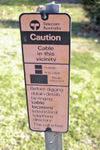
Australian telecommunications services were originally controlled by the Postmaster-General's Department (PMG). On 1 July 1975, separate commissions were established by statute to replace the PMG. Responsibility for postal services was transferred to the Australian Postal Commission (Australia Post). The Australian Telecommunications Commission (ATC), trading as Telecom Australia, ran domestic telecommunication services.
In 1989 the ATC was reconstituted as the Australian Telecommunications Corporation.
In 1992 the Overseas Telecommunications Commission, a separate government body established in 1946, was merged with the Australian Telecommunications Corporation into the short-lived Australian and Overseas Telecommunications Corporation (AOTC) which continued trading under the established identities of Telecom and OTC. The AOTC was renamed to Telstra Corporation Limited in 1993. The corporation then traded under the "Telstra" brand internationally and "Telecom Australia" domestically until uniform branding of "Telstra" was introduced throughout the entire organisation in 1995.
Telstra has faced competition since the early 1990s from Optus (Australia's 2nd largest communication company) and a host of other smaller providers. It retains ownership of the fixed-line telephone network, as well as one of two competing pay-TV and data cable networks. Other companies offering fixed-line services must therefore deal with Telstra except Optus, Transact and a few others who have installed their own infrastructure.
National Broadband Network
On 15 December 2008, it was announced that Telstra's bid for the National Broadband Network had been rejected by the Australian Government.[6] This resulted in Telstra's share price nose-diving from $4.12 to $3.36 during trading on the ASX on the 16 December 2008.[7]
On 19 June 2010, Telstra came to a non-binding agreement with the Australian government to particpate in the National Broadband Network. In exchange for AU$ 11 billion, Telstra will de-commision its copper and HFC broadband networks and transfer all customers to the NBN once it is completed.[8]
Branding
From 1998, Telstra used the slogan "Making life easier", however this slogan was dropped in 2000. The original Telstra logo introduced in 1993 symbolised a telephone receiver beneath the leg of the "T", however, coinciding with the launch of the Next G Network in late 2006, Telstra began to replace this with a modified logo where leg of the T is no longer implied. Initially this logo was rendered in a 3D "bubbly" effect and used brighter colours than the 2D variant, however Telstra's branding team dropped this 3D effect in early 2007, reverting to the original corporate colours. More recently, Telstra have chosen to use simply the "T" from the logo in advertising and promotional material.
Privatisation
Telstra was privatised in three different stages, informally known as T1, T2 and T3 in 1997, 1999 and 2006.[9] In T1, the government sold one third of its shares in Telstra for $14 billion AUD.[9] In 1999, a further 16% of Telstra shares were sold to the public, leaving the Australian government with 51% ownership. In 2006, T3 was announced by the government and was the largest of the three public releases, reducing the Government's ownership of Telstra to 17%.[10] The 17% remainder of Telstra was placed in Australia's Future Fund, which will provide superannuation and pensions for Australia's public servants.[11] In 2009 the Future Fund sold off another $2.4B worth of shares reducing the government's stake in Telstra to 10.9%.[12]
Proposed structural separation
On 15 September 2009, the Australian Government announced plans to structurally separate Telstra into two separate entities; a retail and wholesale arm.[13] Senator Stephen Conroy, Minister for Broadband and Communications, has stated to Telstra that the company can either "break itself up or (the government) will do it for them".[14]
Services
Fixed Lines

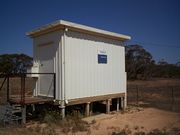
Telstra is Australia's dominant and largest provider of Fixed Line services. These include home phone, business and other PSTN products. Due to Telstra owning the majority of Australia's copper network, this has allowed them to become the dominant provider of these services.
Telstra outsources a significant portion of network installation and maintenance to private contractors and joint ventures, such as ABB Communications and STCJV (Siemens Thiess Communications Joint Venture).[15]
Telstra also owns and maintains the majority of Australia's public telephones. In 2006, Telstra announced it would remove many of the phones citing unprofitability due to vandalism and the increasing take-up and use of mobile telephones.[16]
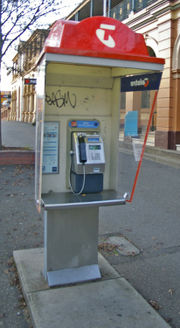
Telstra Mobile
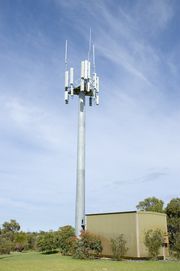
Telstra Mobile is Australia's largest mobile telephone service providers, in terms of both subscriptions[17] and coverage.[18] Telstra operates Australia's largest GSM and 3G UMTS (branded as Next G) mobile telephony networks in Australia,[19] as well as holding a 50% stake in the 3GIS Ltd 2100 MHz UMTS network infrastructure, shared with Hutchison (Three). As of September 2007, Telstra had an estimated 9.3M mobile subscribers .[17] Telstra Mobile services are available in post-paid and prepaid payment types, known as Telstra Pre-Paid (formerly communic8 Pre-Paid).[20]
Telstra's GSM network was the first digital mobile network in Australia. It was launched in April 1993 on the 900 MHz band as "Telstra MobileNet Digital".[21] The GSM network has carried the majority of Telstra's mobile subscribers for the last 10 years and has seen numerous upgrades. 1800 MHz capacity channels were added to the network in the late 1990s as well as GPRS packet data transmission capabilities. As part of the UMTS Next G deployment, the GSM network was also upgraded to a full EDGE data transmission capability in 2006 providing data transmission capabilities greater than 40kbit/s on its GSM network.[22]
In 1981, Telstra (then Telecom Australia) was the first company to provide mobile telephony services in Australia. The first automated mobile service operated in the major capital cities on 500 MHz using the '007' dialing prefix. This network only provided "car phone" capabilities to subscribers as portable handheld terminals were not practical at that time. The first cellular system in Australia offering portable handheld phones was launched by Telstra in 1987 using the AMPS analogue standard on the 800 MHz band. This network at its peak had over 1 million subscribers, but was mandated by the government to be closed down by the year 2000, partially due to privacy concerns which resulted from the AMPS technology, but also because of arrangements undertaken to secure sufficient interest in the GSM network licenses offered in 1992 to competitors. A license condition placed on Telstra to maintain an equivalent coverage footprint at the time resulted in Telstra deciding to deploy an IS-95 CDMA based network in its place.
Telstra has 7000 Next G Base Stations.[23]
Internet

Telstra provides internet subscription and various internet services (such as IP networking, email, servers and network hosting) through its range of subsidiaries.
- Telstra Internet Direct provides internet subscription, services (including IP networking and email) to businesses, government and enterprise. Telstra Internet Direct is mainly focused on business customers and does not sell its products to residential customers unless they have an ABN (Australian Business Number)
- Telstra BigPond provides internet subscription (Cable, ADSL, Wireless and Dialup) for residential customers as well as small business. BigPond is Australia's largest internet service provider with over two million subscribers.
- Telstra Wholesale resells or leases telecommunications products (including dial-in ports, exchange space, and ADSL DSLAM ports) to other companies for the purpose of resale at a fee.
Telstra Internet
Telstra Internet is the national internet backbone for Telstra, within Australia. Telstra sells direct (business-grade) connections to the backbone under the Telstra Internet Direct name, and consumer Dialup, ADSL, Cable Modem and Satellite connections under the BigPond brand name.
Telstra acquired the national backbone of AARNet in 1995 and renamed it to Telstra Internet. Telstra Internet buys long-haul capacity and international transit from REACH Global Services.
Wholesale

Telstra Wholesale[24] provides products such as Data, Mobile, Voice, and other Facilities (including Colocation and Duct Access)[25] to other companies and organisations for re-sale.[26] Telstra Wholesale also provides operational support for its customers,[27] and facilities for international customers such as International Data Transport and IP Transport.[28]
Due to Telstra's position as Australia's incumbent telecommunications provider, Telstra Wholesale is the incumbent and dominant wholesaler of ADSL services to other Internet Service Providers. Telstra installed the first DSLAMs in exchanges prior to 2000, and began wholesaling access in late 2000.[29] Telstra Wholesale has a comprehensive network of ADSL DSLAMs (the largest in Australia) and allows competitors access to each Telstra DSLAM at ADSL1 speeds.
BigPond
Telstra owns and operates the largest cable internet network in Australia. Telstra Cable operates in selected cities of Australia (Sydney, Melbourne, Brisbane, Perth, Adelaide and the Gold Coast), providing downstream speeds of up to 30 Mbit/s in selected areas. Telstra announced they are planning to upgrade their cable network in Metropolitan areas to allow downstream speeds of up to 100Mbit/s. The upgrade was scheduled to complete in Melbourne by Christmas 2009, and launched the new DOCSIS 3.0 services on December 1, 2009 before the deadline. Telstra provides internet services for personal and business clients, through its internet service provider (ISP), BigPond. BigPond provides internet products over various delivery methods, including:
At the end of the 2007 financial year, BigPond had over two million broadband subscribers.[30] The existing customer base of Bigpond Wireless is currently being migrated over to the Next G network, which offers higher speeds and greater coverage.
On 10 November 2006, Telstra made two major changes to their ADSL network. The first was an increase of wholesale ADSL speeds from 1.5 Mbit/s/256 kbit/s to 8 Mbit/s/384kbit/s. Telstra also released an ADSL2+ broadband service offering download speeds of up to 24 Mbit/s from exchanges where competitors were already offering ADSL2+ services.
On 6 February 2008, Telstra announced that it would activate high-speed ADSL2+ broadband in a further 900 telephone exchanges serving 2.4 million consumers across every state and territory in Australia. Telstra also claimed that it has received assurances from the Government that it would not be forced to wholesale these services to other providers, and that the move came "after the Government made clear it did not consider a compelling case had been made for regulating third-party access to the service – an assurance sought by Telstra for more than one year."[31]
On 10 June 2008, it was announced that Telstra was in discussions with some wholesale customers in reference to wholesaling ADSL2+ services.[32]
In January 2009 Telstra was ranked top Australian ISP, in terms of performance, by Epitiro, with Optus placing at 5th position.[33]
Telstra Shops
Telstra owns and operates a series of retail stores known as Telstra Shops and the newer T-Life Stores. The stores exist in many different formats ranging from those fitted in the mid 1990's, through to Telstra Stores in which demonstration phones are fully operational. Telstra is currently in the process of progressively converting all Telstra Shops to T-Life Stores.
Subscription television
Telstra's Hybrid Fibre Coax (HFC) (commonly referred to as "Cable") network is one of the delivery systems used by the Australian Subscription Television provider Foxtel. Telstra owns 51% of Foxtel in a joint venture with News Corporation and Consolidated Media Holdings. Telstra also resell Foxtel's "Digital" to customers in Foxtel's service area (as "Foxtel from Telstra").Telstra offers discounts for Telstra full-service fixed line customers, with internet, pay TV and/or mobile services with Telstra. Such discounts can include free installation and the first month of the best Foxtel package (all channels) for free.[34]
Directories and advertising (Sensis)

Sensis is Telstra's wholly owned advertising and directories arm. This subsidiary was originally known as Pacific Access (since 1991), before changing its name to Sensis in August 2002.[35] Sensis publishes Australia's White Pages and Yellow Pages telephone directories, and in 2004 purchased the Trading Post, a classified advertising periodical. In 2008 management of the Trading Post was transferred to Telstra. In 2009 the printed Trading Post was shut down. Sensis also manages several websites including:
- Yellow Pages Online: an online version of the print directory
- White Pages Online: an online version of the print directory
- Yellow Advertiser: dedicated online resources for Yellow advertisers
- Sensis.com.au: an Australian search engine
- WhereIs.com: online maps and street directories
- CitySearch: city-based lifestyle and entertainment guide
- GoStay: online accommodation booking
- Home at Yellow: a home improvement website
- SouFun: a China-based property website
Sensis is responsible for Telstra's telephone directory assistance call centres - including 1223 ("Telstra Directory Assistance"), 12456 ("Call Connect"), 1225 ("International Directories") and 1234 ("1234").
In 2007 Sensis commissioned Amdocs to develop a customer interaction and database management system dubbed "iGen" to combine the existing GENESIS (also known as POST) system and the company's dozens of other internal customer and account systems into one interface. The new system would combine both Yellow Pages and White Pages directory information on one system.
The original cost of development and implementation was estimated at $300 million AUD which was funded by Telstra, but a twelve month delay in deployment and lack of user acceptance testing almost doubled the original cost. "iGen" was eventually deployed to mass disapproval from employees who experienced extremely low performance and reduced capabilities from the new system.[36] In November 2009, the entire White Pages directory product reverted to the legacy system, GENESIS, after realisation by Sensis management that iGen was incapable of delivering expected performance.
Market position and power
When the Australian telecommunications industry was deregulated in the early 1990s, Telstra successfully used a combination of strategies to maintain its market dominance to fend off market newcomer Optus. Telstra found a strategy of offering lower rates on some routes and at certain times of day, even though its prices, on average, were higher than its rival's was more likely to prevent consumers from switching. Ultimately, Telstra was able to retain several points of market share it otherwise would have lost.[37]
Telstra's market dominance extends beyond its historical PSTN voice and private data business, into newer markets such as Internet Access, Hosting, and Colocation services. In spite of competition from both foreign and domestic challengers, the former PTT is perceived to have retained a strong grip on many of the country's most profitable customers.
Optus remains the company's nearest rival for lucrative business networks. However, Telstra supplies almost twice as many customers in the ASX200 with Dedicated Internet Access services.
In March 2008, all 7 judges in the High Court of Australia, the highest court of appeal in Australia, ruled that Telstra has the right to use the telephone lines, but does not own them.[38]
Criticisms
BigPond rates poorly in independent customer satisfaction surveys, in both customer service and value for money. Choice Magazine in October 2007 found BigPond the worst provider for both ADSL and Wireless internet.[39] A previous survey found less than a third found BigPond to be good value for money and just as few would recommend BigPond to a friend.[40] In this survey, BigPond came second last, with Dodo coming last.[40]
In 2008-09, 104,000 Telstra users complained to the Telecommunications Industry Ombudsman, up from 51,000 in 2007-08.[41]
Fibre-to-the-node (FTTN)
Telstra is advocating the development of a nationwide FTTN network which, in conjunction with VDSL2 technology, would enable up to 100 Mbit/s symmetric download and upload speeds to the home. Competitors, such as the G9, have proposed similar developments, with both Telstra and G9 making progress on various fronts including political and regulatory expectations and funding.
Telstra has indicated that it will not proceed with building the network until it receives regulatory certainty that it will not be forced to wholesale FTTN access to competitors at rates it believes are unfair.
On 26 November 2008, Telstra submitted a non-complying tender issued by the federal government to build a National Broadband Network. Instead of following the tender guidelines, Telstra submitted a 12 page letter proposing a $5 billion broadband network covering between 80 and 90 per cent of Australia, in particular, only major cities, despite the tender requiring 98 per cent coverage.[42][43]
Telstra was removed from the National Broadband Network RFP process on the 15th of December 2008. According to a spokesman for the Communications Minister Stephen Conroy "The expert panel has determined that Telstra’s submission to the national broadband network is not compliant. They are out of the process now."[44]
As retaliation for being excluded from the NBN bidding Telstra has announced that it will raise speeds on its existing Next G network and HFC "cable" network so that they both offer higher speeds that the RFP for the NBN requires.[45]
Following Telstra's exclusion from the National Broadband Network bidding process Telstra's share price suffered the biggest one day percentage fall in its history.[46]
Employment
- Empty cells have no data available for that year. All results as at 30 June.
| Year | Domestic full-time staff | Full-time staff and equivalents | Total workforce | Reference |
| 1995 | 73,307 | 86,885 | Annual Report | |
| 1996 | 76,522 | 88,995 | Annual Report | |
| 1997 | 66,109 | 76,990 | Annual Report | |
| 1998 | 57,234 | 66,760 | Annual Report | |
| 1999 | 52,840 | Annual Report | ||
| 2000 | 50,761 | 53,055 | Annual Report | |
| 2001 | 44,874 | 48,317 | Annual Report | |
| 2002 | 40,427 | 44,977 | Annual Report | |
| 2003 | 37,169 | 42,064 | Annual Report | |
| 2004 | 36,159 | 41,941 | Annual Report | |
| 2005 | 39,680 | 46,227 | 52,705 | Annual Report |
| 2006 | 37,599 | 44,452 | 49,443 | Annual Report |
| 2007 | 35,706 | 43,411 | 47,840 | Annual Report |
| 2008 | 33,982 | 42,784 | 46,649 | Annual Report |
| 2009 | 31,662 | 39,464 | 43,181 | Annual Report |
In April 2006, the appointment of Fiona Balfour saw Vish Padmanabhan demoted to his previous role of deputy CIO.[47]
On 6 February 2007, Chief Information Officer, Fiona Balfour left the company 10 months after she joined the company from 14 years with Qantas.[48]
Telstra's employment policies have been the subject of some criticism. On ABC's (Australian Broadcasting Corporation) documentary program Four Corners, Telstra's COO Greg Winn was revealed to have stated "We run an absolute dictatorship and that’s what’s going to drive this transformation and deliver results... If you can’t get the people to go there and you try once and you try twice... then you just shoot ‘em and get them out of the way..."[49]
Research has shown the deregulation of the Australian telecommunications industry has changed employment relations (ER) at Telstra. Between 1992 and 2009 Telstra's ER strategies included large-scale downsizing and outsourcing. It moved dramatically toward unitarist (anti-union) ER approaches, with a shift away from collective bargaining toward individual employment contracts.[50]
In May 2009, Solomon Trujillo stood down as Chief Executive Officer to return to the United States. David Thodey took over the role.[51]
International expansion
Telstra has expanded into international markets.
- 1992: Telstra Europe - The Telstra Group has been operating in Europe since 1992. Telstra Europe has a customer base of over 7000 customers, who buy data, voice and complex managed network and hosting services [3].
- 2001: 100% of TelstraClear, New Zealand's third largest telecommunications provider after Telecom New Zealand & Vodafone New Zealand. It has its own fibre networks in major cities, is building regional fibre backhaul, has a hybrid fibre-coax network providing phone, internet, & TV services (in Wellington, Christchurch and Kapiti), and resells Telecom New Zealand's phone & data services nationwide (including a mobile agreement). The company was formed in 2001 from the merger of subsidiary TelstraSaturn (a 50/50 joint-venture with Austar which had previously acquired ISPs paradise.net and NetLink) and the telco Clear Communications purchased from BT Group plc.
- 2003: 50% of Reach, an Asian undersea cable venture, with Pacific Century Cyberworks. This partnership was created during the late 1990s telecommunications boom - it struggled and had its book value downgraded to zero by Telstra in February 2003. Reach's debt was renegotiated in 2004 and it was restructured to operate mainly as a vehicle for its owners' international requirements.
- 2005 Telstra rated top IP VPN provider in Asia by Gartner.[52]
- 2006: 51% of China's SouFun, a real estate and property website. SouFun will be integrated into the Sensis business and provide Telstra with an entry point into China.[53]
- 2006 Telstra appoints new head Andrew Morawski of Telstra International Americas business unit.[54]
- 2006: 76.4% of New World Mobility, the largest mobile operator in Hong Kong with 34% of the market in 2006. Telstra originally acquired 60% of CSL (the former Hong Kong Telecom's mobile arm) from Pacific Century Cyberworks, then the remaining 40%, before merging it with New World Mobility.[55]
- 2007 Telstra appoints new head Simon Vye of Telstra International Europe business unit.[56]
- 2008: 100% of the Telstra Endeavour communications cable linking Sydney and Hawaii. The cable went live in October 2008,[57] with a capacity of 1.28 terabits per second in the future (currently at 80 gigabits per second.)
- 2008: Telstra acquired controlling stakes in the two businesses, Norstar Media and Autohome/PCPop, for an undisclosed amount.[58]
- 2009: Telstra acquired a 67% interest in both China M and Sharp Point.
- 2009 Telstra creates expanded International Division and names Hong Kong CSL Limited CEO Tarek Robbiati as Division Head.[59]
Sponsorship
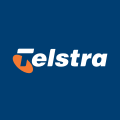
Australia
Telstra and Nintendo Australia made a joint venture in 2005 that was to establish Wireless Wi-Fi Hotspots in restaurants around Australia so Nintendo DS users could connect to the internet to view HTTP/HTTPS pages on Nintendo's Nintendo DS Browser and Nintendo DS games that was Nintendo WFC enabled.
Sporting
Telstra had naming rights to the Telstra Dome in Melbourne, but lost these rights to Etihad Airways, the national airline of the United Arab Emirates, from 1 March 2009 onwards.[61] Telstra is also the naming rights sponsor of the National Rugby League Premiership. Telstra is also the principal sponsor of Swimming Australia. They also sponsored Minardi for the 2002 F1 season and Rally Australia up to 2006.[62]
New Zealand
Telstra also has the naming rights (under TelstraClear) for the TelstraClear Pacific events centre in Manukau City, New Zealand.
References
- ↑ 1.0 1.1 "Telstra Sale: Background and Chronology". Parliament of Australia Parliamentary Library. 2003-09-15. http://www.aph.gov.au/library/pubs/chron/2003-04/04chr03.htm#appendixc. Retrieved 2010-04-11.
- ↑ 2.0 2.1 2.2 2.3 "Telstra Corporation Limited Financial Results for the Year ended 30 June 2008". Telstra Corporation Limited. http://www.telstra.com.au/abouttelstra/investor/financial_summary.cfm. Retrieved 2010-04-11.
- ↑ "Telstra Profit 2009". The Age. http://business.theage.com.au/business/telstra-flags-weaker-growth-20090813-eipa.html.
- ↑ "Telstra - Australia's largest telephony company". Bloomberg L.P.. http://www.bloomberg.com/apps/news?pid=10000081&sid=ajV689nDfO4w&refer=australia.
- ↑ "Telstra - Australia's largest cable provider.". CNET Networks. http://www.cnet.com.au/broadband/cable/0,239035953,339282022,00.htm?feed=pt_telstra.
- ↑ "Telstra's Announcement to ASX about NBN exclusion". Australian Securities Exchange. http://www.asx.com.au/asxpdf/20081215/pdf/31f5s2sd5t98tp.pdf.
- ↑ "Telstra share price history". Australian Securities Exchange. http://www.asx.com.au/asx/research/CompanyInfoSearchResults.jsp?searchBy=asxCode&allinfo=on&asxCode=TLS#chart.
- ↑ http://www.smh.com.au/execute_search.html?text=telstra&ss=Business Sydney Morning Herald 22 June 2010, Telstra deal with govt.
- ↑ 9.0 9.1 "Australia - Privatisation of Telstra". http://www.budde.com.au/Reports/Contents/Australia-Privatisation-of-Telstra-2739.html.
- ↑ "Government's final share in Telstra". http://www.theage.com.au/news/national/telstra-share-slump-may-force-delay/2005/08/17/1123958124821.html.
- ↑ "Australian Future Fund". http://www.futurefund.gov.au/.
- ↑ "Future Fund dumps $2.4 billion of Telstra shares". http://www.itnews.com.au/News/153600,future-fund-dumps-24-billion-of-telstra-shares.aspx.
- ↑ "Separation Article". IntelligentInvestor.com.au. http://www.intelligentinvestor.com.au/articles/Telstra-TLS/Telstra-structural-separation-coverage.cfm?articleID=1020426.
- ↑ "Separation coverage". BusinessSpectator.com.au. http://www.businessspectator.com.au/bs.nsf/Article/FULL-COVERAGE-Telstra-structural-separation-pd20090915-VW3ZJ?OpenDocument.
- ↑ "List of Telstra contracted companies that supply home phone lines". Telstra. http://www.telstra.com.au/movinghome/newhome.cfm. Retrieved 2010-04-11.
- ↑ "Telstra to cut number of pay phones". http://www.abc.net.au/7.30/content/2006/s1574374.htm. Retrieved 2010-04-11.
- ↑ 17.0 17.1 "Telstra Reports 2 Million Hsdpa Subscribers". cellular-news. http://www.cellular-news.com/story/28136.php. Retrieved 2008-04-05.
- ↑ "Telstra to make Next G biggest, fastest in world". The Age. http://www.theage.com.au/news/business/telstra-to-make-next-g-biggest-fastest-in-world/2007/02/13/1171128974088.html. Retrieved 2008-04-05.
- ↑ "About Telstra - Fact Sheet - Mobiles". http://www.telstra.com.au/abouttelstra/corp/facts/mobiles.cfm. Retrieved 2010-04-11.
- ↑ Telstraprepaidplus.com.au
- ↑ "GSM Roaming Australia". http://www.gsmworld.com/roaming/gsminfo/cou_au.shtml.
- ↑ "EDGE Databank". http://www.gsacom.com/gsm_3g/edge_databank.php4#EDGE_Fact_Sheet.
- ↑ [1]
- ↑ "Telstra Wholesale Website". http://telstrawholesale.com.
- ↑ "Telstra Wholesale Products and Solutions". http://telstrawholesale.com.au/products/.
- ↑ "Information on becoming a Telstra Wholesale customer". http://telstrawholesale.com/dobusiness/become-a-customer/become-a-customer.htm.
- ↑ "Telstra Wholesale Operational Support". http://telstrawholesale.com.au/operationalsupport.
- ↑ "Telstra Wholesale International". http://telstrawholesale.com.au/products/international.
- ↑ "Telstra pressure increases as more ISPs join ADSL race". Whirlpool (website). 2000-09-05. http://whirlpool.net.au/article.cfm/118. Retrieved 2006-10-14.
- ↑ "Annual Report 2007 - Full Year Results and Operations Review (Page 46)". http://www.telstra.com.au/abouttelstra/investor/docs/tls542_fyr2007.pdf.
- ↑ "Telstra ADSL2+ 'spin' is breathtaking". http://www.itwire.com/content/view/16489/1095/.
- ↑ "Telstra's reversal: now it plans to wholesale ADSL2+". http://www.commsday.com/node/237.
- ↑ "Telstra". http://www.epitiro.com/news/telstra-retains-top-spot-as-australian-broadband-performance-edges-up.html.
- ↑ Foxtel Summer Deal by Telstra
- ↑ Sensis Pty Limited (2002-08-19). Pacific Access launches new corporate brand - Sensis. Press release. Accessed on 8 March 2008.
- ↑ [2]
- ↑ Roberts, JH (November 2005), "Defensive marketing: How a strong incumbent can protect its position", Harvard Business Review 83 (11): 150, http://hbr.org/2005/11/defensive-marketing/ar/1
- ↑ The Age article containing High Court ruling against Telstra
- ↑ Choice.com, Choice - ISP satisfaction survey
- ↑ 40.0 40.1 "Telstra's BigPond bombs out with consumers". News Limited. 7 December 2007. http://www.news.com.au/technology/story/0,25642,22885016-5014108,00.html.
- ↑ The Daily Telegraph (7 December 2009). "Telstra wants customers to help fix customer service". Adelaide Now. http://www.adelaidenow.com.au/news/national/telstra-wants-customers-to-help-fix-customer-service/story-e6frea8c-1225807555215. Retrieved 2 March 2010.
- ↑ Labor network tender a farce: Minchin
- ↑ Telstra enters NBN race
- ↑ "Telstra's NBN bid rejected". www.news.com.au. 2008-12-15. http://www.news.com.au/story/0,27574,24800767-15306,00.html. Retrieved 2008-12-15.
- ↑ "Telstra not beaten yet on broadband". The Age. 2008-12-16. http://www.theage.com.au/national/telstra-not-beaten-yet-on-broadband-20081215-6z3x.html?page=-1. Retrieved 2008-12-16.
- ↑ "Telstra, Macarthur push Australian sharemarket down 2pc". The Australian. 2008-12-16. http://www.theaustralian.news.com.au/business/story/0,28124,24809234-20142,00.html. Retrieved 2008-12-18.
- ↑ Westpac hires ex-Telstra CIO: News - Business - ZDNet Australia
- ↑ Balfour leaves Telstra, Australian IT
- ↑ Four Corners - 18/06/2007: Tough Calls
- ↑ Ross, Peter (October 2009), "Strategic choices in pluralist and unitarist employment relations regimes: a study of australian telecommunications", Industrial and Labor Relations Review 63 (1): 24–41, http://digitalcommons.ilr.cornell.edu/ilrreview/vol63/iss1/2/
- ↑ Thodey takes Telstra's reins as Sol heads home Australian IT, 19 May 2009
- ↑ "Telstra Rated Top IP VPN Prover in Asia". TCMnet. http://www.tmcnet.com/usubmit/2005/dec/1216504.htm.
- ↑ "Telstra Media Release: SouFun acquisition complements Sensis growth strategy". Telstra Corporation Ltd. http://www.telstra.com.au/abouttelstra/media/mediareleases_article.cfm?ObjectID=38238.
- ↑ "Telstra Corporate Press Release". EWorldwire. http://eworldwire.com/pressreleases/13939. Retrieved 03-22-06.
- ↑ "CSL Corporate Profile". Hong Kong CSL (website). http://www.hkcsl.com/inside/corp_prof/index.html.
- ↑ "Telstra Europe has new CEO". Light reading. http://www.lightreading.com/document.asp?doc_id=114328. Retrieved 01-10-07.
- ↑ Telstra Endeavour Live
- ↑ "No. 228 (27/06/08) - Telstra acquires majority stake in leading Chinese online advertising businesses". Telstra Corporation Ltd. http://www.in.telstra.com.au/ism/corporatenews2008/no228270608telstraacquiresmajoritystakeinleadingchineseonlineadvertisingbusinesses.asp.
- ↑ "New CEO, New Units". ITWire. http://www.itwire.com/it-industry-news/strategy/29699-telstra-another-ceo-another-shake-up. Retrieved 11-30-09.
- ↑ Telstra Brand
- ↑ Telstradome.com.au
- ↑ http://www.worldrallychampionship.net/2006/australia/ Telstra Rally Australia
External links
- Telstra Australia
- Telstra Internet Network Performance Reports
- Telstra Internet Direct
- Next G: Telstra's 3G 850 MHz network
- Telstra Global
- Telstra America
- Telstra Europe
- TelstraClear (New Zealand)
- Telstra BigPond Internet
- Telstra's 3GSM product offering
- Nowwearetalking.com.au
- Sensis corporate site
- Telstra T3 Prospectus
Data
|
|||||
|
|||||
|
|||||
|
|||||
|
||||||||
|
|||||||||||||||||